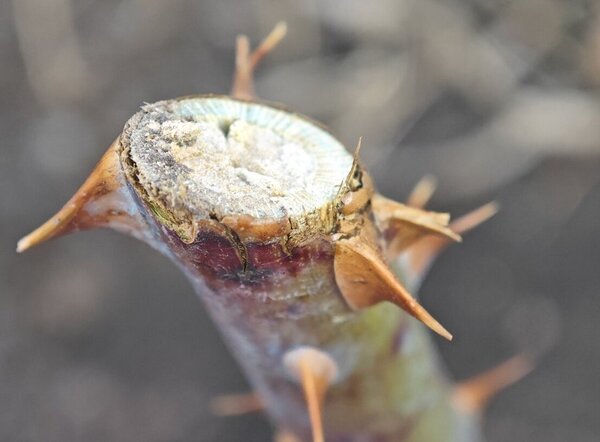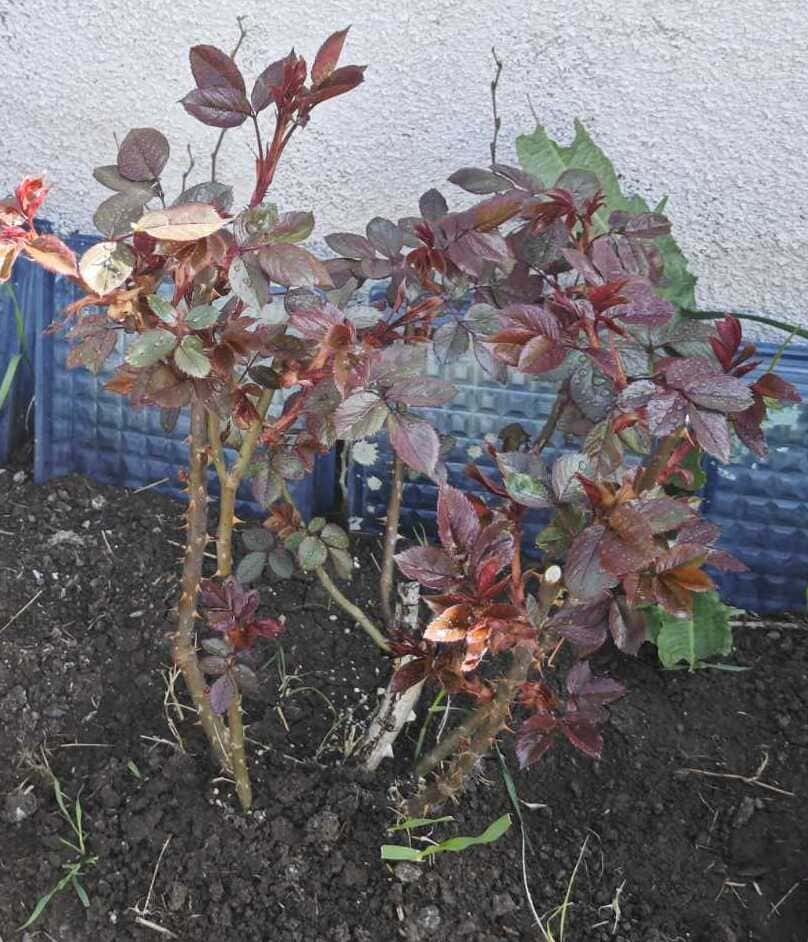Spring is coming soon! Our beauties will wake up from their sleep and will delight us with their lush bloom again. But sometimes roses are in no hurry to wake up. Have you ever had it so that everything around you came to life, the foxes bloomed, and one rose stood like a dry stump? I encountered this last year. My once magnificent Queen Elizabeth rose bush looked like a bunch of dry sticks. This is a harrowing sight for every gardener; many would sigh, dig up, and throw away this stump. But do not rush; give the rose another chance. If you’re facing a similar scene, don’t panic! Many roses take their sweet time waking up, especially after a harsh winter. In this guide, I’ll share exactly how I coaxed my “dry stump” of a rose back to life so you can do the same.
1. Check for Life Signs
Before you declare your rose a goner, do a quick “scratch test.” Gently scratch the bark of a stem with your fingernail. If the layer beneath is green, your rose is alive and merely resting. Another giveaway: look for tiny, red, or green bumps—these swelling buds are baby leaves in the making!
Key Tip
If the wood underneath the bark appears brown or brittle, prune it away. But don’t discard the entire plant at once. Perform multiple scratch tests on different branches before trimming.
2. Prune Dead or Weak Growth
Pruning is crucial when reviving a dormant bush. Grab a sterilized pruning shears and carefully snip away any blackened, dry, or brittle stems. Aim to cut at a 45-degree angle just above an outward-facing bud. This technique signals the plant to grow new branches outward, promoting better air circulation and a healthier structure.
Try to cut off all the dead wood; the rose doesn’t need it.
Sometimes, the remaining stump doesn’t show any buds; that’s exactly what happened to my rose. Don’t despair; this isn’t the end) Roses always have hidden buds that they release in emergencies.
Why It Matters: Pruning dead wood prevents fungal diseases, opens space for new Growth, and channels the rose’s energy into viable branches.

3. Warm Up the Roots
Roses, like us, love warmth and wake up when the temperature suits them. The most important thing for a rose is not the flowers and stems but the roots that are alive. Then the rose will definitely wake up, even if there seem to be no signs of life on top. You need to change the mulch that was left over from winter. Start by gradually removing thick mulch as the temperature rises. Cold, damp mulch can keep the soil cold, inhibiting new Growth. Consider adding dark compost mulch around the base if the days are warming up but the nights are still cold. Dark materials absorb and retain heat, helping the soil stay cozy.
Personal Experience: I noticed a dramatic change in my rose’s vigor once I replaced old mulch with a warm, nutrient-rich compost. The stems seemed to perk up almost overnight!

Get Your Free Lunar Gardener's Calendar 2025!
Join the Lunar Gardening Revolution! Subscribe now to receive our exclusive Free Lunar Gardener’s Calendar for 2025. Harness the power of the moon to optimize your planting, nurturing, and harvesting.
4. Water Properly
Water is life—but too much water in cold soil can be a rose’s downfall. After winter, the ground can remain chilly and damp, so you’ll want to water deeply but infrequently. This encourages more profound root growth, making your rose more resilient in the long run.
Key Tip
Quick Check: Poke your finger into the soil about two inches deep. If it feels dry, it’s time to water. If it’s still moist or cool, hold off. Overwatering in cold soil can lead to root rot, which is harder to remedy.
5. Give It a Boost with Fertilizer
Once you see those tiny buds forming, a gentle feeding can help speed up the wake-up call. Sprinkle a balanced rose fertilizer around the drip line (where the outer leaves would fall) and water it. Alternatively, dissolve 1 tablespoon of Epsom salt per gallon of water and use this solution to promote bushier Growth.
Key Tip
Epsom salt (magnesium sulfate) supports chlorophyll production, producing more vigorous leaves and stems. But use it sparingly—once or twice in the early growing season is plenty.
6. Stimulate Growth with a Gentle Wake-Up Spray
When my rose stubbornly clung to dormancy, I tried a mild hydrogen peroxide spray, and it made a remarkable difference. Mix 1 teaspoon of hydrogen peroxide in 1 liter of water and lightly mist the soil and lower stems. This helps oxygenate the roots, giving them a little extra “breath of fresh air.”
Caution: Avoid spraying if temperatures are still hovering near freezing. Wait for a mild day, and don’t soak the stems— a light mist is enough to do the trick.
7. Make a Mini Greenhouse
When my rose looked like a “dry stump,” I crafted a simple greenhouse from a clear plastic container. This one step worked wonders to maintain a warm, humid microclimate around the plant.
- Cut the bottom off a clear plastic jar or container.
- Gently place it over the rose, leaving enough room for new Growth.
- Open the container periodically to let in fresh air and prevent mold.
Within days, I noticed the buds swelling faster, and soon, my “dry stump” started shooting out bright green leaves.
8. Provide Plenty of Sunlight
Roses love the sun and grow best with at least six hours of direct sunlight daily. If your plant is in a shady spot, consider moving it to a sunnier spot once it has stabilized. Don’t touch the rose before then; give it time to recover. A weakened plant may die when transplanted.
Tip for Container Roses:
If your rose lives in a pot, move it to the sunniest spot in your garden or patio once the danger of frost has passed.
9. Protect Against Late Frosts
Spring weather can be unpredictable. A sudden overnight frost can damage or kill tender new buds. To safeguard your rose:
- Cover it with burlap, a frost cloth, or even an upside-down bucket at night.
- Uncover it during the day to let it bask in the sunlight and avoid moisture buildup.
Remember: Frost damage can set back your plant’s Growth, so take extra care until you’re sure winter’s bite has genuinely left.

10. Be Patient
This is the hardest step for many gardeners, including me! Oh yeah, I checked on my beauty every day, eager to see what would come of my quest to revive her. Some rose varieties, especially old garden roses, and hybrid tea roses, are notorious for being late bloomers. They are often a few weeks behind other roses, but that doesn’t mean they won’t bloom magnificently when they are ready. Warmer weather and consistent care will eventually bring them out of dormancy.

A Story of Triumph
By following the steps above, I was able to revive my rose. Look at her in the photo. She bloomed like crazy all summer, grateful for her rescue.
The moral of the story: Roses have amazing resilience. With patience, proper care, and some gardening skills, even the most dull stump can become a gorgeous rose bush after the winter.
Frequently Asked Questions about Wake Up a Rose After Winter
Yes. Some roses, especially older varieties, can be notoriously slow to wake up. Perform the scratch test on different branches. If you see green beneath the bark, there’s still hope. Keep the soil slightly moist, ensure it’s receiving some warmth, and be patient.
Water deeply, but only when the top two inches of soil feel dry. Early spring soil retains moisture longer, so it’s usually best to water sparingly until temperatures rise.
Yes—pruning is best done in late winter or early spring, before or just as new Growth emerges. Removing dead and weak wood ensures the rose channels energy into healthy branches.
It’s generally safe to fertilize when you see leaf buds forming. Start with a balanced rose fertilizer or an Epsom salt solution to encourage strong, healthy Growth. However, avoid heavy fertilization in cold weather, which can stress the plant.
Cover your rose with burlap, frost cloth, or even an inverted bucket at night if temperatures are expected to drop. Uncover the plant daily to prevent moisture buildup and allow sunlight in.
Not always. If you live in a milder climate, your rose may not need the extra protection. However, a mini greenhouse can give them a much-needed head start for areas with unpredictable spring weather or severely weakened roses.
Waking up a rose after winter might feel daunting, but a gentle, consistent approach is key. Check for signs of life, prune wisely, warm the roots, water correctly, feed sparingly, and be patient. Whether you’re dealing with an heirloom variety that’s taking its sweet time or a modern hybrid that just needs a bit of TLC, these tips will help guide your rose into a new season of Growth and beauty.
Now it’s your turn. Put on your gardening gloves, step outside, and start your dormant rose fresh. Trust me—once those first blossoms open and that signature fragrance drifts through the air, you’ll know every careful step was absolutely worth it!
Happy Gardening—and may your roses bloom abundantly!
Want more gardening tips? Subscribe to our newsletter for monthly advice straight to your inbox!

